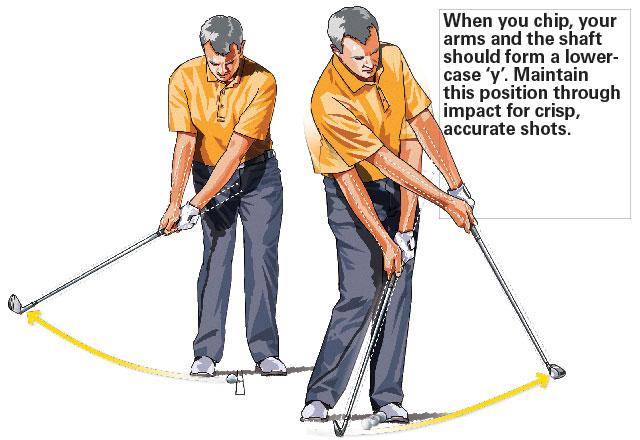A golfer’s repertoire will almost certainly include at least one chip shot. That’s why it’s so crucial to develop a routine. This will help you consistently get the ball within striking distance of the hole to reduce your score.
In this post, in addition to discussing several chipping techniques, we will discuss the definition of a chip shot. We will also show its uses and which clubs are appropriate to employ in various scenarios.
Below is our best effort at describing how to chip in the golf game. And this is for those who struggle with chipping occasionally.
What Exactly is The Chip Shot?

Before you learn how to chip in golf, you need to know what is a chip shot. The chip would be a short-game shot often used from around forty yards out and closer to the green. Most of the time, you will need to take a very brief swing to hit the ball down the green. And then, you will need to let the ball go toward the hole.
On the golf course, typical circumstances that require the use of a chip shot are as follows:
- You are currently in the rough adjacent to the green & have a small amount of green to play.
- You are on edge, and putting would be impractical at this point (too far / severe contours between you and the hole).
- You are in the tract close to the green or in an area closely mown adjacent to the green.
When and Why Should You Chip It?
In addition to knowing how to chip in golf, you should know when and why to use this technique. Now, if there aren’t any slopes, bunkers, and mounds to go over, a solid general rule of thumb suggests that you must play a shorter chip shot – frequently referred to as the chip and run. You do this to get the ball rolling as quickly as possible. The ball will travel farther if you hit a lower shot.
You must also remember that perhaps the putter is the better club to use if the ball is slightly off the green or when the fringes have been cut very closely.
The most important thing to remember when chipping
The most common error golfers make when chipping is trying to lift the ball into the air with their hands. Because of this, the action is flicky, and there is little room for error. This causes the golf ball to either thin out as it travels past the green or makes contact with the surface before time.
Hence, focus on touching the grass underneath the ball and letting the loft on your golf club do the work rather than attempting to lift the ball yourself. This will allow the loft to do its job more effectively.
When you swing the golf club through level / slightly down, you have a massive window of opportunity to connect the club face and the golf ball. This may appear paradoxical, but it’s essential to keep in mind. So, please remember this advice before learning how to chip in golf.
How to Chip in Golf

Now that you are familiar with the most critical aspects of chipping, we will discuss the technical aspects of a fantastic chipping movement. So, here’s how to chip in golf!
Chipping Setup
Everything that happens after you stand in the chipping motion is determined by how you stand. However, if you can spend a little time perfecting your setup, chipping will become very easy for you.
Keep your fingers further down the golf handle, and shuffle your feet closer to the ball as you play. This provides you with a greater degree of control over your chip shots.
Put approximately sixty percent of your weight through the front of the foot. This helps make it much simpler to get a good strike on your chip shots.
Chipping Swing
After you have gotten into position, all that is necessary of you is a slight rotation of the body back and through for the ball to jump into the air & continue moving ahead.
If you make sure that your body turns back and through and keep your hands and arms relatively solid, you will have an excellent foundation to build the chipping. And the technique for chipping remains the same regardless of the club you use.
As was just mentioned, the vast majority of beginning players and a significant number of club players attempt to assist the ball in rising into the air. This is improper because doing so results in a wide variety of shots missing their target.
Instead, it would help if you aimed to strike the golf ball at a slightly downward angle and brush the grass underneath the ball while still moving the club in the direction of your objective.
A great swing thought would be to swing the club at your goal while maintaining the club head low to its ground. This will help you hit your target more consistently.
Great chippers keep the club moving forward through impact, move their bodies toward the goal, and avoid flicking their wrists. So, congratulations! Now you know how to chip in golf.
How to Adjust the Distance of Your Chip Strokes When Playing Golf
Learning how to chip in golf is just the beginning! Maintaining proper distance control becomes second nature when you have mastered the fundamental skill.
- Make a quick backswing and follow through to chip shorter shots.
- Take a longer swing back and across the ball if you want your chip to be longer.
- Instead of attempting to hit the ball harder during chipping, strive to control its distance by varying the duration of the chipping stroke.
Should the length of your backswing & the length of your through swing be precisely the same?
This is correct, but if you achieve a positive result with your swing-through, you will discover that your follow-through is significantly longer than the backswing. So, this works out perfectly.
How to Get Better at Chipping the Ball

On the chipping green, grab five balls and move back ten yards until you are ten yards away from the hole. Try to chip each ball with the 9-iron to see how many shots you could get within one club length (worth three points) and two club lengths (worth six points) (1 pt).
Continue playing the game, but this time move back fifteen yards.
Moving among these distances will significantly assist you in learning how to chip and use the length of the chipping swing to command distances. So, if you continue moving between such two distances, you will eventually know how to chip in golf.
Which Clubs Are Best for Chip Shots?
Selecting a suitable club becomes crucial when learning how to chip in golf. Since they provide the perfect equilibrium between trajectory & rollout, short irons & wedges (such as a 9-iron, a gap wedge, a pitching wedge, etc.) are the most regularly utilized clubs for hitting chip shots.
Shorter irons can create chip shots with a more incredible trajectory and, therefore, less rollout than longer irons.
For amateurs and beginners, a pitching wedge would be a versatile club that serves various purposes. After some time, you can move on to additional clubs when you have developed good technique and feel.
When playing golf, it’s not uncommon for players to take a bump-and-run shot from off the green with a wood or hybrid club.
For example, imagine that you are just off the green, 70 feet away from the hole, and have plenty of green to play.
So, to obtain a lower trajectory and much more rollout, one potential approach could be to use a greater lofted iron. This would allow for more rollout. Alternatively, you might use a higher loft wedge and make a more powerful swing to transport the ball further.
Thus, the player must use discretion to decide which method to use.
One of the Most Frequent Blunders is to Flick at It
A typical mistake made when chipping would be to flick at the ball to help it get back up. Because clubs can have up to sixty degrees of loft or more, you don’t need to flick at it to lift the ball up in the air.
So, to fix, a helpful drill is to push an aligning stick down the shaft of such a club. Hence, it sits under the lead arm while in the address position.
If you attempt to flick the ball while you come right back into the ball, the clubhead will try to overtake the hands even as impact occurs, and the stick may hit the lead side.
When you hit the ball, avoid turning your wrists and focus on maintaining everything from now on during impact.
Conclusion
Knowing how to chip in golf is essential for any player who wants to improve their game and should not be ignored.
Chipping is a facet of the game that may be improved upon, and doing so is highly recommended. So, continuously moving up and down is the single most effective way to save a round.
Frequently Asked Questions
Where Should the Golf Ball Be Positioned Before Chipping?
Always land on the heel or the ball of the foot; never in the space between the feet.
The result will not be good if the ball is positioned between the feet for both low & high strokes because it affects how far the ball travels. When you want to hit the ball high, place your golf ball on the right foot. This will give you greater loft, resulting in the ball flying higher. When taking shots from a low angle, you ought to use the rear foot (reduced loft means the ball will stay low to the ground).
Should You Hit the Golf Ball Down When Attempting to Chip It?
When chipping, you have to strike the ball low because the loft on the golf club should be high enough to launch the ball up in the air if you hit it higher.
When chipping, the hands should be in front of the club & your weight should be in the front position. This will help you maintain the leading edge down, as this is the primary goal of chipping.
To ensure that you make adequate contact with your golf ball and stay in play, you hit it at a downward angle of attack.
Does Chipping Require the Clubface to Have an Open Position?
The clubface must be open to chip, which is determined by the type of shot being played.
For instance, when the shot needs to travel high to carry thick rough, a bunker, or a hazard, extend the clubface to add loft (thus, creating good height).
When there is a considerable amount of space between you & the objective, it is customary to bring the clubface closer to the ball. In situations like this, a more closed clubface prevents the leading edge from rising too much.
How to chip and make it stop?
Backspin and a proper lie angle of the golf ball seem to be the two elements that will work together to make the chip shots stop more quickly.
Most golfers work on raising the amount of backspin on the chips. Still, a much simpler and more effective strategy is to raise the trajectory of the chip shots rather than work on increasing the amount of backspin.
Why do my chip shots always shank?
Now, you can force the ball to contact the hosel of the club instead of the middle ground on the club face. But this results in a shank. The primary cause is placing excessive body weight, mostly on heels, during the setup phase.
If you shift the weight toward the middle of the feet throughout the swing, the club head will move further out, and you’ll end up hitting the hosel instead of the perfect spot.
To avoid this, balance the weight over the middle of the feet at setup. And also maintain that position throughout the swing.
If you are having trouble, try setting up such that the weight is more on the toes. You won’t touch the hosel from this position unless you fall over.








